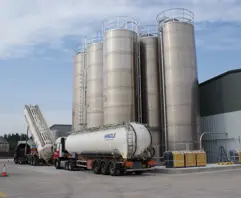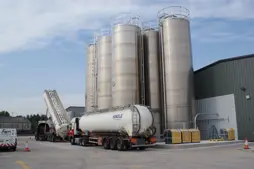The Detail
The system uses a single vacuum-conveying exhauster to assemble the dry ingredient additions into the client’s mixer. It then vacuum conveys the mixed batch from the mixer to formulation vessels and wax pellets from drums into wax melt vessels.
The five dry ingredients (comprising flour, sugar and different types of oats) are all delivered in sacks of various sizes, and each ingredient has a dedicated sack tip, located on a mezzanine floor level, into which they are decanted. We have installed a dust extraction system to remove air-borne dust created during the tipping of the sacks. This extraction system is automatically operated when a sack tip door is opened. Below each sack tip is a dedicated weigh hopper, installed at ground level. Pre-weighed batches are gathered into the vessels, controlled by screw feeders on the sack tip outlets. Our system is designed so that, on demand of the control system, the pre-weighed ingredients are simultaneously conveyed to a receiving vessel, installed above the mixer. When the operators are ready, they discharge the accumulated weighed batch into the mixer.
Once mixed, the total batch is discharged from the mixer directly into a vacuum conveying line, and conveyed to the formulation vessels. Due to the extremely low headroom conditions of this site, it was not possible to use conventional receiving vessels to dis-entrain the mixed product from the conveying line. IBS have developed a unique style of receiving vessel for these low headroom applications and have been used with great success on this application.
The poison additions involve pumping the various liquids from floor mounted IBC’s to a 50 litre capacity polyethylene holding vessel, with point level detection. The poisons vessel is installed above the mixer. The liquid poison enters the mixer during the mixing process, fully automated by the process control system.










